Table Of Contents
- 1Introduction
- 2What is EdTech Solution?
- 3How Does EdTech Solutions Work?
- 4What Are Some of the Must-Have Features of Edtech Solutions
- 5Types of Educational Technology Solutions
- 6Beyond Video Conferencing: An In-Depth Analysis of Today’s EdTech Solution Landscape
- 7Top EdTech Solutions Provider for 2025
- 8Pros and Cons of Using EdTech Solutions
- 9Challenges of Implementing EdTech Solutions
- 10Future of Educational Technology Solutions
- 11Careers in Education Technology
- 12Conclusion
Introduction
From interactive whiteboards in Texas to AI-powered tutoring in New York, Education Technology (EdTech) is revolutionising how American students learn. With over 130,000 K-12 schools and nearly 4,000 degree-granting postsecondary institutions, the U.S. is at the forefront of this digital education boom.
The global education technology market size was estimated at USD 163.49 billion in 2024 and is projected to reach USD 348.41 billion by 2030, growing at a CAGR of 13.3% from 2025 to 2030.
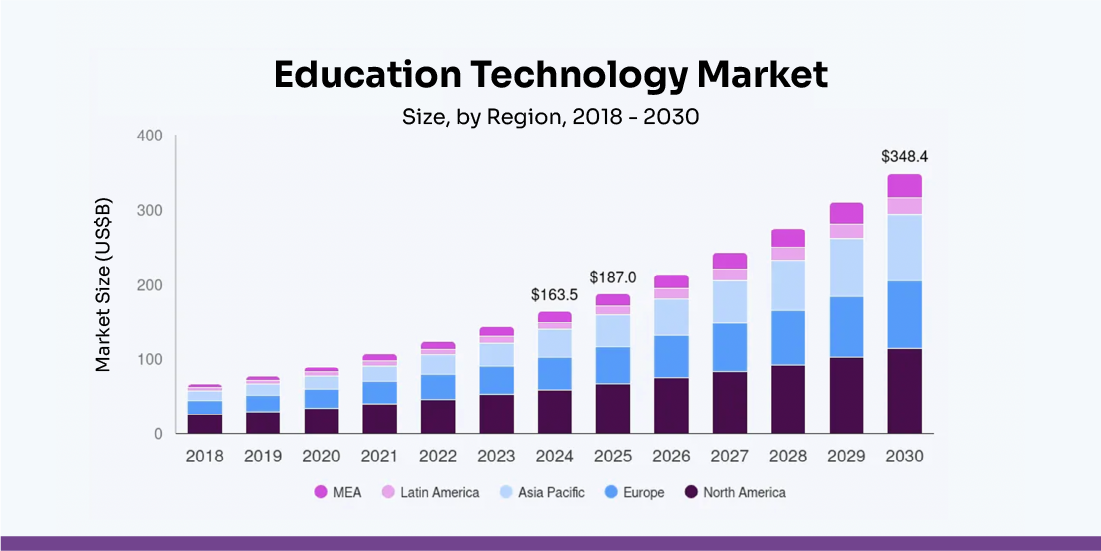
Smart classrooms, online learning platforms, and AI-integrated assessment tools fuel this surge.
Google for Education, used by over 170 million students and educators globally, is deeply embedded in U.S. schools. Tools like Google Classroom and Chromebooks dominate classrooms, with 58% of U.S. school devices running on Chrome OS as of 2023.
Meanwhile, U.S.-based companies like Khan Academy and Duolingo have redefined supplemental learning. Khan Academy, in partnership with districts like Los Angeles Unified, provides free personalised SAT prep and math support, reaching millions of students.
In higher education, platforms like Coursera for Campus are empowering universities to offer Ivy League-level learning experiences. Over 200 U.S. institutions now integrate Coursera into their curriculum, giving students access to real-world, job-ready skills.
From AI tutors like Socratic by Google to immersive AR/VR labs in STEM classrooms, U.S. education is embracing a tech-first mindset. These tools aren’t just supporting learning—they’re transforming it.
EdTech in America isn’t the future—it’s the now. And every byte of innovation is building a smarter, more inclusive educational experience for all.
What is EdTech Solution?
Before jumping to the best EdTech service providers, let us briefly understand what EdTech is.
EdTech, short for Education Technology, refers to the use of digital tools, software, and platforms to enhance teaching, learning, and educational administration. It’s where technology meets education to make learning more interactive, personalised, and accessible.
In simpler terms, EdTech transforms a traditional classroom into a dynamic digital learning environment. This can include anything from:
- Online learning platforms like Coursera, Udemy, or Khan Academy
- Classroom management tools like Google Classroom or ClassDojo
- AI-based tutoring apps such as Duolingo or Quizlet
- Virtual Reality labs for subjects like biology or engineering
- Learning Management Systems (LMS) such as Canvas or Blackboard are used in universities.
EdTech isn’t just about gadgets—it’s about empowering educators and students. For example, a teacher in Ohio can now assign homework via Google Classroom, track student progress in real-time, and even use AI to recommend support materials for struggling learners.
In the U.S., the shift to EdTech accelerated during the COVID-19 pandemic. Over 93% of households with school-age children reported engaging in distance learning in 2020 (U.S. Census Bureau). But instead of fading post-pandemic, EdTech has evolved into a permanent fixture in American education.
From rural schools gaining access to top-tier content to college students mastering career-ready skills via online certifications, EdTech is making education smarter, faster, and more inclusive.
Hence, EdTech is not replacing teachers—it’s empowering them, while giving students the tools to thrive in a digital-first world.
How Does EdTech Solutions Work?
Educational Technology (EdTech) combines digital tools, data, and modern pedagogy to make teaching and learning more accessible, engaging, and efficient. Instead of replacing educators, it extends their reach—automating repetitive tasks, personalising instruction, and opening new ways for students to experience content.
1. Cloud-Based Learning Platforms
Modern LMSs live entirely in the cloud, so courses, readings, and quizzes update in real time. Students can log in from any device, while faculty push one change that instantly reaches an entire cohort. Centralising everything this way slashes IT headaches and makes accreditation audits smoother.
Ohio University’s Canvas roll-out hit 93 % of all courses by Jan 2025, up from 83 % just three months earlier—evidence of near-universal LMS penetration in North American higher ed.
2. AI-Driven Personalisation
Algorithms watch how quickly a learner advances, which questions they miss, and even when they study. The system then adjusts content difficulty, recommends remedial videos, or sends motivational nudges. This “just-right” pacing keeps students challenged but not discouraged, boosting persistence.
42 % of students now use Gen-AI tools weekly or daily, alongside 40 % of administrators and 30 % of instructors (Tyton Partners Time for Class 2025).
Georgia State University’s “Pounce” chatbot cut summer-melt by 50 % and lifted FAFSA completion by 16 %.
3. Automated Assessment & Feedback
Machine-scoring engines grade multiple-choice items in seconds and use natural-language processing to review essays for structure, originality, and tone. Instant, objective feedback means learners correct mistakes sooner, and instructors reclaim hours for deeper coaching or course redesign.
4. Intelligent Process Automation (IPA)
Document-AI tools read transcripts, passports, and recommendation letters, extract the data, and push it straight into CRM and SIS platforms. By eliminating manual re-typing, admissions teams issue decisions days or weeks faster and can redeploy staff to high-touch advising.
A La Trobe University IPA project automated results publishing and saved 13,500 staff hours per year—the equivalent of six full-time roles.
5. Analytics Dashboards & Early-Warning Systems
Behind the scenes, click-stream, grade, and attendance data flow into predictive models that flag when a student is slipping. Advisors get colour-coded dashboards that prompt timely outreach, turning potential dropouts into successful completers and protecting tuition revenue.
6. Immersive & Extended Reality (XR)
VR headsets and AR overlays create safe, realistic labs for tasks that are too risky, costly, or distant in real life—think chemistry reactions or archaeological digs. Students gain hands-on practice and muscle memory, which significantly improves concept retention.
University of Arizona students now prototype store designs inside a VR twin of the Lundgren Consumer Science Lab, launched in spring 2025 within the campus AI Core program.
What Are Some of the Must-Have Features of Edtech Solutions
With thousands of education apps competing for attention, the solutions that succeed in 2025 share a common DNA: they blend AI-powered personalisation, rock-solid data security, and seamless integrations that let teachers focus on teaching instead of tech. Below are the core features any serious EdTech platform should ship from day one.
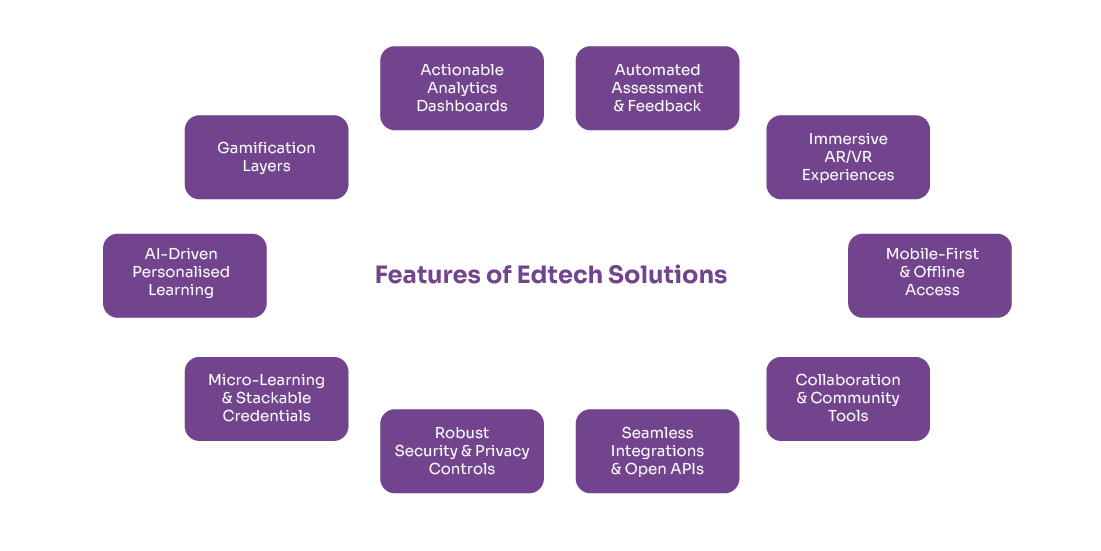
- AI-Driven Personalised Learning – Adaptive engines tailor content, pacing and remediation to each learner’s performance and preferences, raising engagement and completion rates.
- Gamification Layers – Points, badges and leaderboards turn lessons into quests, boosting motivation without sacrificing rigour.
- Actionable Analytics Dashboards – Real-time visual reports for students and faculty surface progress, gaps and next-best actions; natural-language query tools make data self-serve.
- Automated Assessment & Feedback – Auto-grading for quizzes, essays and interactive videos gives instant, meaningful feedback while freeing faculty hours for high-touch coaching.
- Immersive AR/VR Experiences – Virtual labs and field trips provide safe, hands-on practice in subjects from chemistry to history, deepening conceptual understanding.
- Micro-Learning & Stackable Credentials – Bite-sized modules issue digital badges and micro-credentials that map directly to workforce skills, supporting lifelong learning.
- Robust Security & Privacy Controls – Single sign-on, encryption and routine AI audits protect sensitive data and maintain trust under FERPA/GDPR.
- Seamless Integrations & Open APIs – Standards-based connectors plug the platform into SIS, CRM, and video tools, preventing data silos and duplicate entry.
- Collaboration & Community Tools – Built-in chat, shared whiteboards, and video breakout rooms make group projects and peer feedback frictionless across time zones.
- Mobile-First & Offline Access – Responsive design and local caching keep learning continuous on any device—even with spotty connectivity—critical for equity and scale.
Types of Educational Technology Solutions
Educational Technology spans a spectrum of tools—from cloud platforms to immersive media—each designed to solve a different teaching-and-learning problem. Understanding the main categories helps institutions choose the right mix for pedagogy, access, and scale. Below is a concise map of the most common types of EdTech in 2025.
1. Learning-Management & Courseware Systems (LMS/MOOCs)
Cloud platforms such as Canvas or Coursera host content, quizzes, and discussions so learners can engage asynchronously while instructors track progress in one hub.
2. Synchronous Virtual-Classroom Tools
Video-conferencing suites (e.g., Zoom, Microsoft Teams) enable real-time lectures, breakout rooms, and polls, replicating live classroom interaction for remote cohorts.
3. Mobile Learning (m-Learning) Apps
Smartphone-first apps push micro-lessons, flash-cards, and notifications, letting students learn in “downtime” and keeping engagement high—even where laptops are scarce.
4. AI-Powered Adaptive & Tutoring Systems
Large-language-model tutors and adaptive engines analyse clicks and quiz results to personalise pacing, content difficulty, and feedback in real time.
5. Gamification & Game-Based Learning Platforms
Badges, leaderboards, and quest-style modules turn study into play, boosting motivation without diluting rigour.
6. Immersive AR/VR & Simulation Labs (XR)
Headsets or phone-based AR overlay virtual labs, field sites, or 3-D models, giving students safe, hands-on practice that improves retention.
7. Analytics & Early-Warning Dashboards
Data pipelines pull LMS, CRM, and SIS signals into visual dashboards that flag disengagement or risk, empowering timely faculty intervention.
8. Intelligent Process-Automation Tools
Document-AI services scan transcripts, IDs, and essays, then auto-populate CRM/SIS records—cutting manual workload in admissions and records offices.
9. Collaboration & Social-Learning Platforms
Shared whiteboards, threaded chats, and peer-review portals foster group projects and global classroom communities.
10. Assistive & Accessibility Technologies
Screen readers, speech-to-text, and adaptive interfaces ensure that learners with disabilities can participate fully, advancing inclusion goals.
Beyond Video Conferencing: An In-Depth Analysis of Today’s EdTech Solution Landscape
When you group Educational Technology by audience instead of by gadget, the value proposition becomes clearer: each stakeholder receives tools designed to solve their day-to-day friction. Below is a deeper dive into six core user groups—what kinds of EdTech they rely on, how those tools work, and the tangible benefits they are already delivering in 2024-25.
1. Students
Mobile-first study apps, adaptive courseware, and immersive XR labs now follow learners everywhere. At IIT Delhi, for example, 80 % of students say generative-AI helpers simplify complex concepts and create personalised study aids—though they also flag privacy concerns, showing how fast adoption is moving. Meanwhile, University of Arizona undergrads walk through a digital twin of a retail store in VR to prototype layouts and analyse shopper behaviour—hands-on practice that once required expensive field trips—the payoff: on-demand support, higher engagement, and safe, realistic practice that boosts retention.
2. Teachers & Instructors
For faculty, the heavy lifters are AI lesson planners, auto-grading engines, and data-rich virtual-classroom platforms. A July 2025 Gallup survey found that nearly two-thirds of K-12 teachers used AI this school year, and weekly users saved about six hours of work—time they could redirect to mentoring and feedback.
In higher ed, studies at the University of Georgia confirm that AI graders slash essay-scoring time while still letting instructors override for nuance. Together, these tools lighten the administrative load, surface real-time learning gaps, and allow teachers to focus on the human side of instruction.
3. Educational Facilities & Administrators
Institutions gravitate toward process-automation bots, predictive analytics dashboards, and AI chatbots that scale one-to-many communication. Georgia State University’s “Pounce” chatbot cut summer-melt by 50 % and lifted FAFSA completions by 16 %, proving that round-the-clock nudges can protect tuition revenue.
On the back office side, La Trobe University’s RPA rollout to publish exam results saved 13,500 staff hours a year, converting weeks of manual data entry into near-real-time processing. Results: faster decisions, fewer errors, and staff hours redirected to high-touch advising.
4. Parents & Guardians
Parent portals, secure messaging apps, and attendance-plus-payment trackers give families a live window into a child’s progress. K12’s national parent portal lets caregivers check grades, contact teachers, and plan the school day from a single dashboard; users describe it as “collaborative, flexible, and empowering.”
Similar tools, such as Skyward and Focus SIS, send push alerts for missing assignments and low lunch balances, turning passive observers into active partners in learning. The benefit is more substantial home–school alignment and quicker intervention when problems arise.
5. Policy-Makers & Accrediting Bodies
To improve oversight and reduce fraud, agencies are backing open dashboards and secure digital credentials. Grand Valley State University’s 2025 pilot issues blockchain-based transcript “wallets” that students can share instantly, tamper-free.
At the macro level, the White House’s 2025 AI-literacy drive is funding district-wide AI pilots and teacher training so that every U.S. school can tap vetted tools by fall 2025. These moves create system-wide transparency, speed credential verification, and set common trust standards for emerging tech.
6. Corporate & Workforce Partners
Industry cares about faster up- and re-skilling and verifiable micro-credentials. Corporate e-learning now accounts for nine in ten organisations’ upskilling efforts, with the global market projected to hit USD 350 billion by 2025. Platforms issue stackable badges that map precisely to job skills.
At the same time, VR onboarding modules let new hires practise hazardous tasks in a risk-free environment—cutting training costs and accidents alike. The result is a tighter education-to-employment pipeline and data-driven hiring.
Top EdTech Solutions Provider for 2025
Ed Tech in 2025 is dominated by platforms that pair rock-solid cloud infrastructure with fast-evolving AI toolsets. The leaders below all check three boxes: (1) massive, measurable reach, (2) clear revenue traction or funding strength, and (3) headline-grabbing product releases in the past 12 months.
1. Instructure – Canvas & IgniteAI
Serving 8,000+ institutions worldwide, Canvas became the first “AI-native” LMS after its July 2025 partnership with OpenAI. Faculty can now spin up course-specific chatbots, auto-generate rubrics, and let agentic tools adjust deadlines—all inside the grade-book they already use.
2. Anthology – Blackboard Learn Ultra & campus stack
The merged Anthology + Blackboard suite supports roughly 150 million users in 80 countries. July 2025 releases added the AVA virtual assistant and mastery-learning pathways, reinforcing Blackboard’s reputation as the fastest-evolving LMS for the fourth straight year.
3. PowerSchool – K-12 data & AI ecosystem
PowerSchool pushed deeper into generative AI this year: a family-facing “PowerBuddy” chatbot went live in April, and a May launch introduced an AI-driven Coaching & Mentoring platform that automates observation notes and recommends growth goals for teachers.
4. Coursera – Global skills marketplace
With 183 million registered learners, Coursera posted Q2-2025 revenue of USD 187 million and raised its full-year outlook to as much as USD 746 million. New AI authoring tools are already cutting partner course-build time by 40 percent.
5. Udemy – B2B up-skilling engine
Udemy’s Q2-2025 revenue hit USD 199.9 million; its enterprise arm, Udemy Business, now boasts USD 520 million in annual recurring revenue and 17,000+ corporate customers, keeping the company solidly profitable.
6. Duolingo – Gamified micro-learning powerhouse
The language-learning app logged 46.6 million daily active users in Q1-2025—a 49 percent YoY jump—and is extending its bite-size, game-loop model into math and music to broaden its TAM.
7. Kahoot! – Game-based assessment at scale
More than a billion participants played a Kahoot! Quiz last year. The June 2024 LTI 1.3 upgrade (rolled into 2025 school contracts) lets educators embed live games in any LMS with one click, cementing Kahoot! as the default for real-time formative checks.
8. 2U / edX – University program enablement
The edX network now reaches 96 million learners. A July 2025 expansion with Oxford Saïd Business School added nearly 40 new programs—including an executive AI diploma—showcasing 2U’s ability to blend short courses and full degrees on one platform.
9. Khan Academy – Khanmigo AI tutor
District partners can give every student a 1-to-1 AI tutor and provide teachers a lesson-planning copilot. Typical Sense Media rates Khanmigo four stars, higher than most general-purpose chatbots, reflecting its guardrails and curriculum alignment.
10. GoStudent – Live tutoring & immersive VR
Europe’s most-funded tutoring unicorn is doubling down on immersive learning: the GoStudent Education Report 2025 highlights a 35 percent rise in VR adoption across UK schools and positions the company’s GoVR platform as a catalyst for language-learning engagement.
Pros and Cons of Using EdTech Solutions
Educational Technology (EdTech) can transform classrooms, but the same traits that make it powerful—cloud connectivity, real-time data, and immersive media—also introduce new risks. Below is a balanced look at the key advantages and drawbacks that schools, colleges, and policy-makers are weighing in 2025.
Pros
1. Learning that fits each student
Innovative software watches how fast you pick things up and what you get wrong. It then serves easier or more complicated questions, extra videos, or quick reminders right when you need them. That gentle “just-right” push helps most students move ahead faster than a one-size-fits-all lesson.
2. More spare time for teachers
Automatic quiz-grading and AI lesson helpers do the repetitive chores—like marking multiple-choice tests or drafting worksheets—in minutes. Teachers can use the hours they save to talk with students, plan creative projects, or give detailed feedback instead of chasing paperwork.
3. Catching problems early with data
Because every click, quiz score, and login is recorded, schools get dashboards that flash warnings when a student stops participating or misses a critical form. Staff can call or text the student that same day, preventing minor issues from turning into drop-outs.
4. Learn anywhere, anytime
Lessons stored in the cloud mean you can study on a phone during a bus ride, late at night after work, or in a rural area with no campus nearby. Flexibility like this opens doors for working adults, parents, or anyone far from a traditional classroom.
Cons
1. Unequal access to devices and the internet
Fancy apps are no good if a family has only one old smartphone or a shaky data plan. When high-tech tools roll out before fast, affordable internet reaches everyone, the gap between “haves” and “have-nots” can grow.
2. Privacy and hacking risks
Student records—grades, addresses, even medical notes—sit on servers. If those servers get hacked or a vendor sells the data, kids and families lose control of sensitive information. Schools must invest in strong passwords, encryption, and strict contracts, which can be expensive and complex.
3. Too much screen time
Spending most of the school day on laptops or tablets can lead to eye strain, sleep trouble, and less face-to-face social time. Experts suggest mixing digital lessons with hands-on projects, outdoor activities, and traditional paper-based activities to keep minds and bodies balanced.
4. Budgets that don’t stretch forever
Many districts buy new software with short grants or pilot funds. When that money runs out, yearly subscription fees can bust the budget, forcing schools to drop the tool or cut elsewhere—what some call a “tech cliff.”
5. Training takes time
If teachers don’t get clear, ongoing training, even the best app sits unused or is used in the wrong way. Learning new systems on top of an already full workload can be stressful and uneven, leaving some classrooms high-tech and others stuck in the past.
Challenges of Implementing EdTech Solutions
While EdTech provides many advantages, it also poses challenges for both students and teachers. Common technical issues include poor Wi-Fi connectivity, audio or video distortions, problems with file uploads and downloads, difficulties with software installation, slow internet speeds, password issues, and compatibility problems with applications or updates.
1. Unequal Internet & Device Access
Many learners still lack reliable broadband or a dedicated computer. Without a clear plan for loaner devices, offline modes, or community Wi-Fi hubs, EdTech can widen—not close—the achievement gap.
2. Budget Constraints & Hidden Costs
Licensing fees, cloud storage, cybersecurity insurance, and regular hardware refreshes add up. Grant money may cover the pilot year, but long-term subscriptions and support often strain operating budgets.
3. Teacher Training & Change Fatigue
Educators need time and coaching to weave new tools into existing pedagogy. When professional-development sessions are rushed or optional, usage stays shallow and pockets of resistance grow.
4. Data Privacy & Security Risks
Student information systems now hold grades, health records, and even biometric data. One breach can erode trust for years, so districts must vet vendors, encrypt all data, and comply with laws like FERPA or GDPR.
5. Integration & Interoperability Issues
A shiny new app that refuses to talk to the learning-management system forces teachers into double data entry and students into multiple log-ins. Open standards (LTI, OneRoster) help, but require deliberate IT planning.
6. Measuring Impact on Learning
It’s easy to track log-ins; it’s much harder to prove higher test scores or improved critical-thinking skills. Without clear success metrics, stakeholders lose patience, and funding dries up.
7. Content Quality & Cultural Relevance
Automated or third-party content may not align with local curricula, accessibility guidelines, or students’ cultural backgrounds. Vetting and customising materials demand time and subject-matter expertise.
8. Sustainability & E-Waste
Rapid hardware cycles mean more discarded devices and batteries. Institutions face both environmental and regulatory pressure to adopt greener procurement, recycling, and energy-use practices.
Future of Educational Technology Solutions
Technology is rapidly transforming education, elevating it to new heights. So, how will educational technology shape what comes next? With tools that let teachers monitor student progress, tailor instruction, and create immersive learning experiences, EdTech is poised to become ubiquitous.
1. AI-native platforms become the norm
Canvas’s July 2025 deal with OpenAI lets any instructor spin up a course-specific chatbot, auto-generate rubrics and analyse submissions—all inside the grade-book they already use. Expect other LMSs to follow, baking large-language-model workflows into core screens instead of bolt-on “AI widgets.”
2. Every learner gets a personal tutor—coded, not human
District-wide roll-outs of tools such as Khanmigo show how GPT-style agents can walk a student through a maths proof or draft an IEP outline in seconds. The shift reframes teachers as orchestrators of AI-augmented learning rather than sole content experts.
3. Immersive & spatial learning goes mainstream
Falling headset prices and better authoring software push the VR-in-education market from USD 31 billion in 2025 to USD 81 billion by 2030 (≈ 21 % CAGR). “Digital-twin” labs let nursing students practise intubation or retail-management majors redesign a store layout without leaving campus.
4. Skills-first, lifelong programmes outpace traditional degrees
Analysts see the overall education economy approaching USD 10 trillion by 2030, with the fastest growth in short, employer-aligned courses rather than four-year credentials. Platforms such as Coursera and edX are shrinking course-build time by 40 % using generative AI, then selling the resulting micro-credentials directly to HR teams.
5. Mobile-first design closes (some of) the access gap
In regions where laptops are still scarce, the mobile-learning market is forecast to jump from USD 110 billion in 2025 to USD 341 billion by 2029. Offline caching, micro-lessons and WhatsApp-style chatbots put bite-size learning into every pocket.
6. Ethics and teacher competencies catch up
UNESCO’s 2024 AI Competency Framework for Teachers gives governments a ready-made blueprint for what educators should know about AI foundations, ethics and pedagogy. Expect national PD requirements to align with these guidelines so that guardrails evolve alongside the tech.
7. Money shifts from hyper-growth to sustainability
Venture funding crashed to USD 2.4 billion in 2024—the lowest since 2014—and fell another 35 % in Q1 2025. Investors now reward clear business models and measurable impact, while governments (notably in the MENA region, where Q1 2025 funding jumped 169 %) step in to bankroll AI-literacy and vocational programmes.
8. Yet the market keeps expanding
Even after the VC correction, the core EdTech segment is still set to more than double—from USD 163 billion in 2024 to roughly USD 348 billion by 2030 (≈ 13 % CAGR), powered by Asia-Pacific enrolment booms, AI-driven personalisation and corporate up-skilling mandates.
Careers in Education Technology
EdTech blends learning science with software, data, and design, so career paths span both education and technology. Whether you enjoy teaching, coding, or analysing data, there’s a role that lets you improve how people learn while working with cutting-edge tools. Let’s have a closer look at eight fast-growing EdTech roles:
1. Instructional (Learning-Experience) Designer
- Meet with subject experts, storyboard lessons, build interactive modules in Articulate 360, Storyline or Rise, run small-group pilots, analyse learner feedback, and iterate.
- Learning-science principles (Bloom, Merrill), UX writing, accessibility (WCAG/Section 508), rapid-authoring tools, basic HTML/CSS.
- Where you’ll work: Universities, corporate L&D teams, EdTech vendors, government training units.
2. EdTech Product Manager
- Own the product roadmap, write user stories, prioritise features with engineers, run A/B tests, and translate pedagogy into business value.
- Agile/Lean methods, data analytics (Mixpanel, GA4), market research, stakeholder facilitation, basic instructional-design literacy.
- Where you’ll work: SaaS learning platforms, start-ups, publishing houses moving into digital.
3. Educational Software Engineer
- Code front-end views (React, Flutter) and back-end services (Node, Go, Python) that power LMSs or adaptive engines; integrate AI APIs; write unit tests; ensure LTI 1.3 or OneRoster compliance.
- Full-stack or mobile dev, REST/GraphQL APIs, cloud (AWS/GCP), security best practices, data privacy (FERPA/GDPR).
- Where you’ll work: EdTech scale-ups, university IT departments, learning-content studios.
4. Learning Data Analyst / Education Data Scientist
- Clean LMS click-stream data, build dashboards in Tableau/Power BI, run predictive models (Python/R) to flag at-risk students, and present insights to deans or customer success teams.
- SQL, statistical modelling, data-viz storytelling, ethics & bias checks, domain insight into assessment metrics.
- Where you’ll work: Universities, MOOC platforms, state education agencies, analytics consultancies.
5. LMS / Academic-Technology Administrator
- Configure Canvas or Blackboard terms, manage user roles, troubleshoot plug-ins, train faculty, and integrate SIS/CRM via APIs or SSO.
- Platform administration, change management, basic scripting (Python/Bash), instructional-tech support, project management.
- Where you’ll work: K-12 districts, colleges, corporate academies that run internal LMSs.
6. AR/VR Learning Developer
- Model 3-D scenes in Unity or Unreal, script interactions, optimise for Quest 3 or Vision Pro, work with SMEs to ensure learning objectives, and publish experiences via WebXR or app stores.
- 3-D animation, C#/Blueprints, UX for spatial computing, performance tuning, instructional storytelling.
- Where you’ll work: Simulation labs in healthcare or aviation, EdTech start-ups, museum and cultural-heritage programs, corporate safety training.
7. Customer-Success & Implementation Specialist
- Onboard new schools or enterprises, map workflows, run training webinars, track adoption metrics, escalate bugs, and upsell renewals when value is proven.
- Project planning, consultative communication, fundamental data analysis, familiarity with K-12 or higher-ed processes, empathy for non-technical users.
- Where you’ll work: Any SaaS EdTech vendor—especially LMS, assessment, or chatbot providers.
8. AI in Education Research Scientist / Engineer
- Train and fine-tune LLMs for tutoring or auto-feedback, design prompt-engineering experiments, run RAG pipelines, evaluate learning gains, and publish findings.
- Machine learning (PyTorch/TensorFlow), NLP, ethics & bias mitigation, experimental design, educational measurement.
- Where you’ll work: Large EdTech platforms, AI research labs, university centres for digital learning, corporate R&D groups.
Conclusion
EdTech is now the backbone of U.S. learning, from Google Classroom and Chromebooks (dominant in schools) to AI tutors and VR labs. The global market was about $163B in 2024 and is on track to $348B by 2030 (13% CAGR), driven by smart classrooms, online platforms, and AI assessments. In practice, cloud LMSs centralise courses, AI personalises lessons and automates grading, analytics flag at-risk students, and workflow bots speed admissions. Must-have features include personalisation, real-time dashboards, auto-feedback, AR/VR, micro-credentials, tight security, open integrations, collaboration tools, and mobile/offline access. Big players—Canvas, Anthology/Blackboard, PowerSchool, Coursera, Udemy, Duolingo, Khan Academy, Kahoot!, edX, GoStudent—anchor the ecosystem. Benefits: tailored learning, teacher time saved, earlier interventions, flexible access. Trade-offs: the digital divide, privacy risks, ongoing costs, and training needs. Looking ahead: AI-native platforms, mainstream VR, skills-first credentials, and mobile-first delivery—plus expanding careers across design, data, engineering, and product.

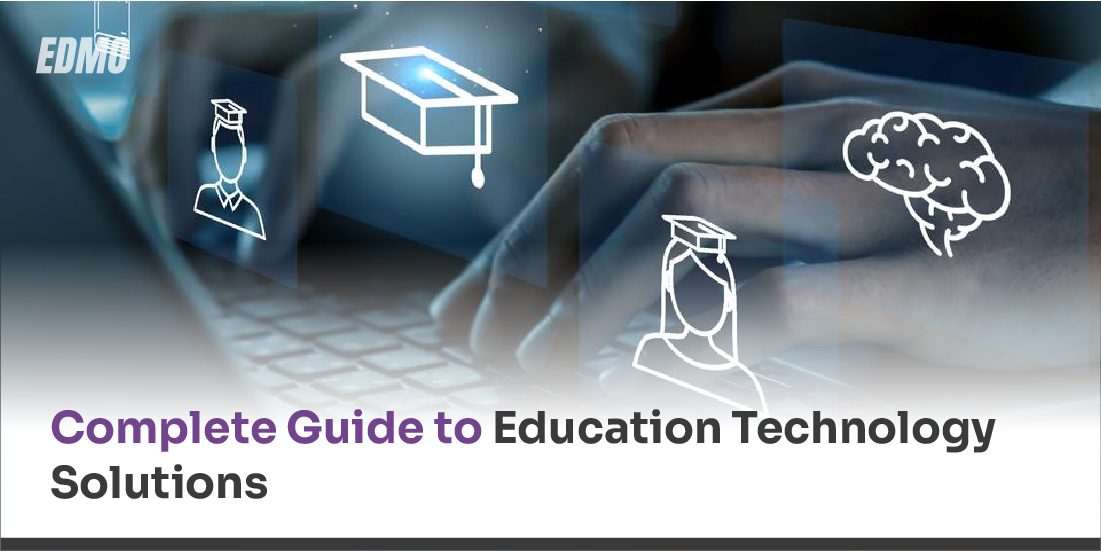
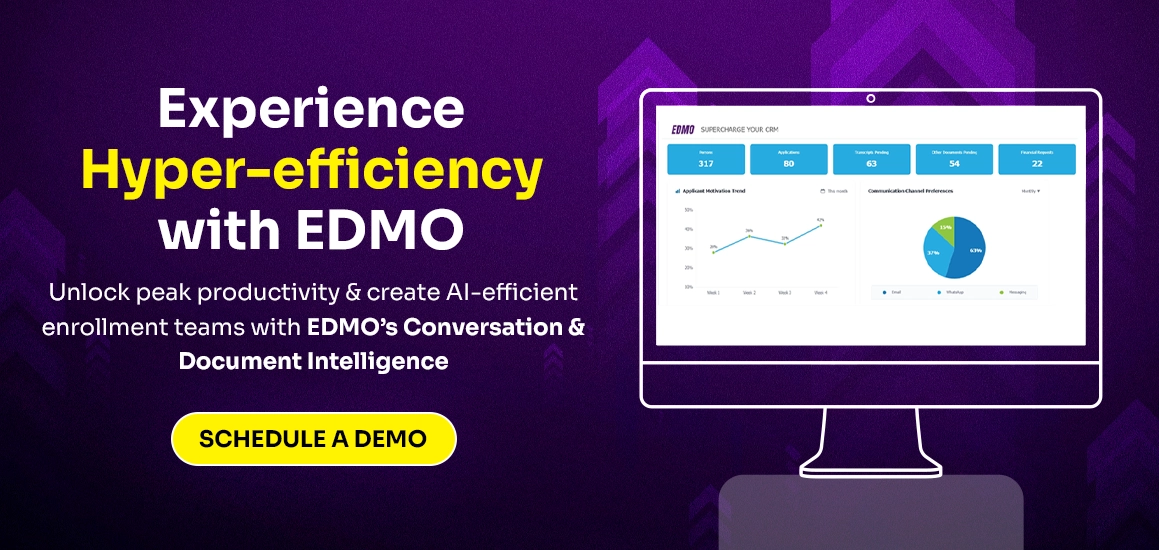




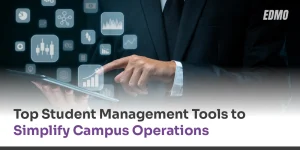
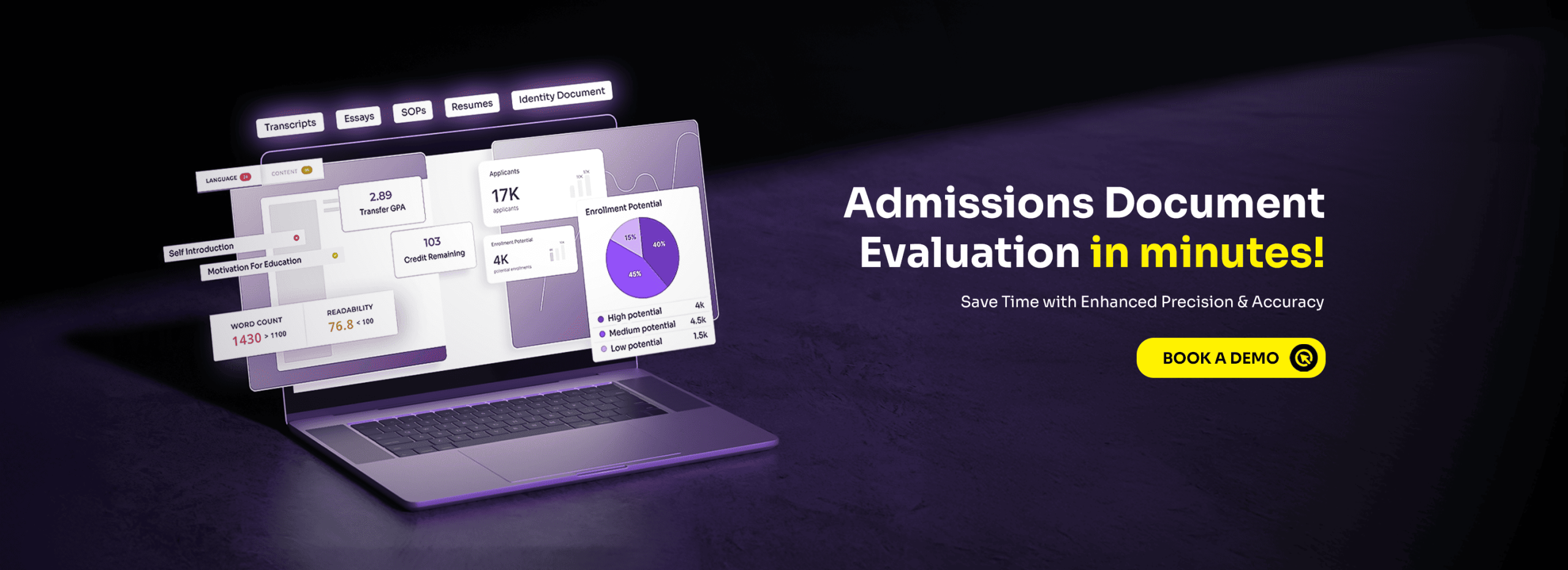

No comments yet. Be the first to comment!
Leave a Comment